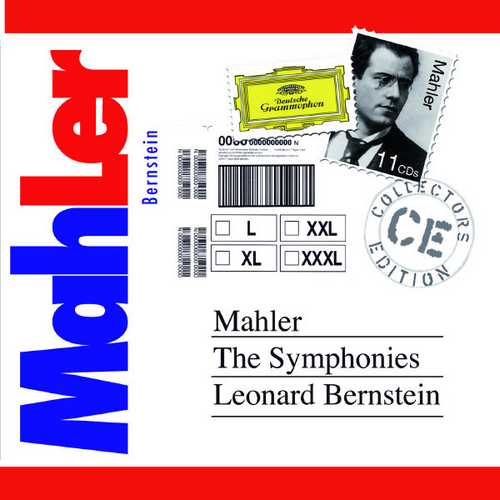
Composer: Gustav Mahler
Performer: Barbara Hendricks, Christa Ludwig, Jaap van Zweden, Helmut Wittek, Margaret Price, Judith Blegen, Gerti Zeumer, Agnes Baltsa, Trudeliese Schmidt, Kenneth Riegel, Hermann Prey, José van Dam, Konzertvereinigung Wiener Staatsopernchor, Wiener Singverein, Wiener Sängerknaben
Orchestra: Royal Concertgebouw Orchestra, Wiener Philharmoniker, New York Philharmonic Orchestra
Conductor: Leonard Bernstein
Number of Discs: 11
Format: FLAC (tracks)
Label: Deutsche Grammophon
Catalogue: 4778668
Release: 2010
Size: 3.19 GB
Recovery: +3%
Scan: yes
CD 01
Symphony No. 1 in D major ‘Titan’
01. 1. Langsam. Schleppend
02. 2. Kräftig bewegt
03. 3. Feierlich und gemessen, ohne zu schleppen
04. 4. Stürmisch bewegt
Symphony No. 2 ‘Resurrection’
05. 1: Allegro maestoso (Totenfeier)
CD 02
Symphony No. 2 ‘Resurrection’
01. 2: Andante moderato
02. 3: (Scherzo)
03. Sehr feierlich, aber schlicht – “O Röslein rot”
04. 5: Im Tempo des Scherzo
CD 03
Symphony No. 3
01. 1. Kräftig. Entscheiden
02. 2. Tempo di minuetto. Sehr mäßig
03. 3. Comodo. Scherzando. Ohne Hast
CD 04
Symphony No. 3
01. 4. Sehr langsam. Misterioso: “O Mensch! Gib acht!”
02. 5. Lustig im Tempo und keck im Ausdruck: “Bimm Bamm. Es sungen drei Engel”
03. 6. Langsam. Ruhevoll. Empfunden
Symphony No. 6 in A minor ‘Tragic’
04. 1. Allegro energico, ma non troppo. Heftig aber Markig
05. 2. Scherzo (Wuchtig)
CD 05
Symphony No. 6 in A minor ‘Tragic’
01. 3. Andante moderato
02. 4. Finale (Allegro moderato)
Symphony No. 9
03. 1. Andante comodo
CD 06
Symphony No. 9
01. 2. Im Tempo eines gemächlichen Ländlers. Etwas täppisch und sehr derb –
02. 3. Rondo. Burleske (Allegro assai. Sehr trotzig –
03. 4. Adagio (Sehr langsam)
CD 07
Symphony No. 5
01. 1. Trauermarsch (In gemessenem Schritt. Streng. Wie ein Kondukt – Plötzlich schneller. Leidenschaftlich. Wild – Tempo I)
02. 2. Stürmisch bewegt. Mit größter Vehemenz – Bedeutend langsamer – Tempo I subito
03. 3. Scherzo (Kräftig, nicht zu schnell)
04. 4. Adagietto (Sehr langsam)
05. 5. Rondo-Finale (Allegro)
CD 08
Symphony No. 7
01. 1. Langsam (Adagio)
02. 2. Nachtmusik (Allegro moderato)
03. 3. Scherzo
04. 4. Nachtmusik (Andante amoroso)
CD 09
Symphony No. 7
01. 5. Rondo – Finale (Allegro ordinario – Allegro moderato ma energico)
Symphony No. 4
02. 1. Bedächtig. Nicht eilen – Recht gemächlich
03. 2. In gemächlicher Bewegung. Ohne Hast
04. 3. Ruhevoll (Poco adagio)
05. 4. Sehr behaglich: “Wir genießen die himmlischen Freuden”
CD 10
Symphony No. 10 in F sharp major
01. Andante – Adagio
Symphony No. 8 in E flat major ‘Symphony of a Thousand’
02. “Veni creator spiritus”
03. “Imple superna gratia”
04. “Infirma nostri corporis”
05. Tempo I. (Allegro, etwas hastig)
06. “Infirma nostri corporis”
07. “Accende lumen sensibus”
08. Veni, creator spiritus
09. “Gloria sit Patri Domino”
CD 11
Symphony No. 8 in E flat major ‘Symphony of a Thousand’
01. Poco adagio
02. Più mosso (Allegro moderato)
03. “Waldung, sie schwankt heran”
04. “Ewiger Wonnebrand”
05. “Wie Felsenabgrund mir zu Füßen”
06. “Gerettet ist das edle Glied” – “Hände verschlinget”
07. “Jene Rosen, aus den Händen”
08. “Uns bleibt ein Erdenrest”
09. “Ich spür’ soeben” – “Freudig empfangen wir” – “Hier ist die Aussicht frei”
10. “Höchste Herrscherin der Welt”
11. “Dir, der Unberührbaren” – “Du schwebst zu Höhen”
12. “Bei der Liebe” – “Bei dem Bronn” – Bei dem hochgeweihten Orte”
13. “Neige, neige, du Ohnegleiche”
14. “Er überwächst uns schon”
15. “Komm! hebe dich zu höhern Sphären”
16. “Blicket auf zum Retterblick”
17. “Alles Vergängliche”
Of the two Mahler cycles Leonard Bernstein recorded in his career, the most influential and culturally important was the first, recorded with the New York Philharmonic in the 1960s and early ’70s for Columbia, then later reissued by Sony. Even though it has been criticized for several faults, not least of which were Bernstein’s willful choices of tempos, phrasing, and dynamics, it has nonetheless been recognized as one of the foundations of the Mahler revival and of true historic value. The second cycle was recorded in the 1980s for Deutsche Grammophon, and though these recordings with the Vienna Philharmonic, the Royal Concertgebouw Orchestra, and the New York Philharmonic were noted for their polish and greater faithfulness to the scores, they were less musically significant overall, for they came after many other conductors had raised performance standards for Mahler recordings, transcended Bernstein’s interpretive powers, and expanded listeners’ range of choices. The DG recordings were gathered in a 1991 box set of 13 CDs and laid out in a sequence fairly close to their numerical ordering, with few breaks between discs. This 2010 set presents the CDs in a trimmed-down box on 11 CDs, with the symphonies dramatically out of sequence and with breaks in all except the Symphonies No. 1 and No. 5. The reduced packaging and squeezed-in programming may be attractive to collectors who like saving space and who won’t listen to the set often, but it will prove to be frustrating and confusing to people approaching Mahler for the first time. While Bernstein’s legacy will hardly be affected by these externals, they are of some consequence to the listener’s ease of playing and satisfaction with the product, which in turn will color reception and may dissuade some from giving this later cycle serious consideration for its musical worth.



